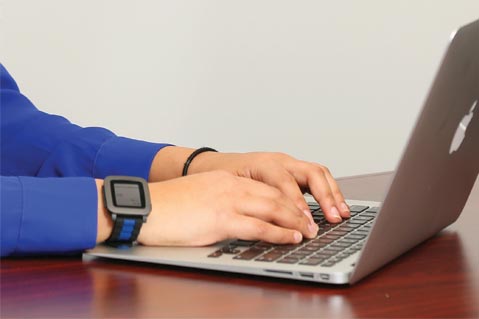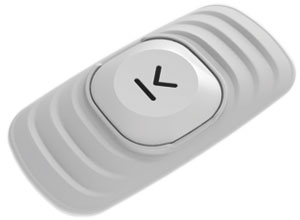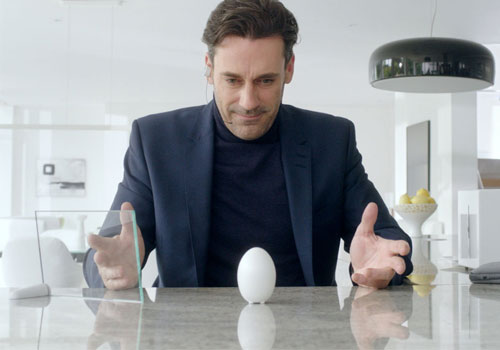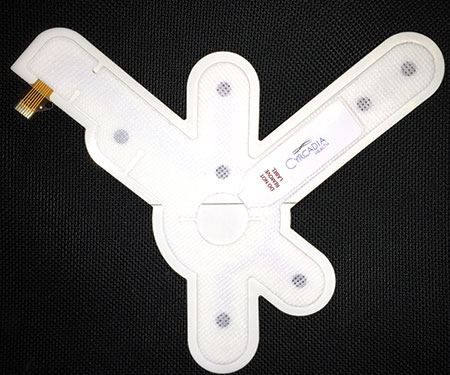Product Hub April 17, 2017
The Future of Wearable Health Devices
These devices just might save your life.
If you’ve seen Netflix’s Black Mirror – a show that explores twisted takes on how technology impacts society – you’re familiar with how innovation can change our day-to-day activities in ways we can’t even imagine. But right now, developers are creating wearable technology – from watches to patches and more – that isn’t just life-changing, but life-saving, in real time.
Image grab from Black Mirror's "White Christmas" episode.
 magine not being able to go on a walk by yourself. That was reality for many years for Kathryn Losea of Casper, WY, after a head injury left her experiencing partial, absence and even grand mal seizures. Losea’s life changed after she connected on Facebook with Julie Hutchison – president of the Chelsea Hutchison Foundation, which offers grants for seizure monitors and seizure dogs, and promotes epilepsy awareness – and received a SmartWatch, created by Smart Monitor, of San Jose, CA. The Hutchison family started the foundation in honor of Chelsea, the daughter they lost to SUDEP (Sudden Unexpected Death in Epilepsy). Smart Monitor donates a percentage of SmartWatch sales to support those with chronic conditions, such as epilepsy, and provides discounts and device donations to many nonprofits.
magine not being able to go on a walk by yourself. That was reality for many years for Kathryn Losea of Casper, WY, after a head injury left her experiencing partial, absence and even grand mal seizures. Losea’s life changed after she connected on Facebook with Julie Hutchison – president of the Chelsea Hutchison Foundation, which offers grants for seizure monitors and seizure dogs, and promotes epilepsy awareness – and received a SmartWatch, created by Smart Monitor, of San Jose, CA. The Hutchison family started the foundation in honor of Chelsea, the daughter they lost to SUDEP (Sudden Unexpected Death in Epilepsy). Smart Monitor donates a percentage of SmartWatch sales to support those with chronic conditions, such as epilepsy, and provides discounts and device donations to many nonprofits.
The impetus for the SmartWatch was a phone call that Anoo Nathan, CEO, received several years ago on Christmas Day, from a single mother whose son’s epilepsy was so severe she had to set hourly alarms to monitor his condition. The SmartWatch monitors movements and sends alerts to designated family members or caregivers when it detects abnormal movement patterns. “I can go for walks alone and not have to worry,” Losea says. The watch has alerted her to four seizures in her two years of ownership. “I’d recommend this monitor to everyone who has a seizure disorder,” she says. “It gives your loved ones peace of mind. I have a lot more of my privacy and independence back. As long as I’m having seizures, I’ll use the watch.”

A father told Nathan that the SmartWatch saved his daughter’s life when he received a text alert and was able to get to her within minutes after a seizure, followed by paramedics. Another family discovered their daughter has seizures in her sleep when they awoke to an alert in the middle of the night. “Users and caregivers can securely access and download event records and activity reports, and archived copies can be sent to care providers for review,” Nathan says. SmartWatch is water-resistant and both iOS and Android compatible. Other features include a “Get Help” button, medication reminders and a snooze option.
Acuma Health, a division of Smart Monitor, also provided the back-end data solution for the Johns Hopkins EpiWatch study. “EpiWatch was designed to use Apple Watch to collect patient data through the open source ResearchKit framework designed by Apple,” Nathan says. “The app, which runs on the Apple Watch and iPhone, collects data from patients with epilepsy before, during and after their seizures.”
Sweating It Out:
Sonia Sousa, co-founder and CEO of San Francisco-based Kenzen, a company using sweat technology to create the ECHO Smart Patch, a one-of-a-kind lifesaving wearable device set to launch in 2017, was inspired by the health quandaries of those closest to her to find answers skin deep.
“A few years ago, my brother found out that he had a very severe and unique case of prostate cancer,” she says. “When we got the news, there was really nothing that could be done anymore. His condition really caught the whole family by surprise, and my first thought was how healthy my brother had always been. He even went through a full physical examination just a few months prior to the diagnosis and everything was fine.”

Sousa’s second thought was: “How can you go from this really healthy state to a very ill condition within a six-month period?” She wondered what would happen if one took existing technology and put it on a person to better understand the processes that happen when a person transitions from well to ill. The idea gelled when she met co-founder of Kenzen, Steve Pecko, who had been diagnosed with Type 1 diabetes when he was 3 years old. “When we met, he had already done over 40,000 ‘finger-stick’ blood glucose tests, and left a high-level job at LinkedIn to discover technologies that can help detect different conditions, including diabetes,” Sousa explains.
Their first product, the ECHO Smart Patch brings together the science of wearable diagnostics, sweat analysis and predictive analytics. It’s currently being targeted at high-intensity athletes and industrial workers in hot/high-risk environments. However, future versions won’t need as much sweat to analyze, so the average consumer will be able to use them, Sousa says. The patch consists of a rechargeable monitor that measures vital signs and motions and a disposable adhesive patch with biosensors that perform the sweat analysis. The ECHO attaches to a user’s torso and connects wirelessly to their smartphone. The patches are intended to be worn continuously for up to 24 hours. There’s a wide range of “critical biomarkers” that can be measured from a “micro-bead of sweat,” Sousa says, including things that are difficult to measure in blood, like hyponatremia (low sodium levels).
 hough it’s still undergoing FDA approval, Biotricity’s Bioflux aims to offer patients with heart issues real-time intelligent cardiac monitoring. “Our medical-grade wearable is a superb example of how IoT devices can have a huge impact on healthcare,” says Waqaas Al-Siddiq, co-founder and CEO of Biotricity, based in Redwood City, CA, and Toronto, ON. “While great progress has been made in the treatment of cardiovascular disease, it’s still listed as the underlying cause of the death of more than 800,000 people in the U.S. each year, making it a perfect application for devices that support built-in IoT capabilities,” he says. “Bioflux will help diagnose patients by tracking and reporting on cardiac activity in real time, 24/7.”
hough it’s still undergoing FDA approval, Biotricity’s Bioflux aims to offer patients with heart issues real-time intelligent cardiac monitoring. “Our medical-grade wearable is a superb example of how IoT devices can have a huge impact on healthcare,” says Waqaas Al-Siddiq, co-founder and CEO of Biotricity, based in Redwood City, CA, and Toronto, ON. “While great progress has been made in the treatment of cardiovascular disease, it’s still listed as the underlying cause of the death of more than 800,000 people in the U.S. each year, making it a perfect application for devices that support built-in IoT capabilities,” he says. “Bioflux will help diagnose patients by tracking and reporting on cardiac activity in real time, 24/7.”

Biotricity’s technology consists of an IoT platform that facilitates cloud connectivity with real-time analysis. Bioflux collects ECG data, analyzes it for anomalies, communicates these anomalies to deal with response scenarios, and stores this information in the cloud. “The key use of Bioflux is to help physicians diagnose patients by collecting their ECG data over a longer period of time, while reducing patient risk,” Al-Siddiq says. “We believe it’ll help caregivers and institutions by providing better diagnostics through longer-term monitoring and an expedited time to final diagnosis, as the report is generated immediately and doesn’t require the device to be sent off for download.”
Cyrcadia Health’s iTBra patches, launching this year, could revolutionize early detection of breast cancer, especially for the estimated 40% to 50% of women in the U.S. with dense breast tissue, which can make traditional screening more difficult. As a monthly breast exam, consumers wear the patches inside a bra for a few to several hours during normal daily activities to detect circadian temperature changes inside breast tissue.
“If you think about something so determined like cancer, and locating it how we normally do in a clinic or a hospital, breast cancer cell division can take many years – six, eight, 10 years – before it becomes large enough to be visualized by the current technologies,” says Roy Royea, Cyrcadia CEO and chairman. “So the main indicator on wearables and the value of a company like Cyrcadia is that we anticipate getting the diagnosis earlier, possibly years in advance.”
Based in Reno, NV, Cyrcadia is involved in research with Ohio State University and El Camino Hospital, in Mountain View, CA, and will be piloting tests at other research hospitals in the U.S. and abroad in 2017. Cyrcadia is especially hoping to help increase early diagnosis in areas with low screening rates, such as Asia.
 lad Ferber and Pierre-Jean “PJ” Cobut, two Stanford University alumni, co-founded Echo Labs in Palo Alto, CA, to create a modern, yet standardized system of health monitoring, combining a clinical platform and medical grade wearables. “Echo Labs was born out of a realization that the healthcare system has very little data about a patient’s state,” Cobut says. “Physicians make important clinical decisions based on snapshots of data: observations and tests made during quick office visits. However, the human body is in constant flux, and data on these changes isn’t available. We formed the company around the idea of making healthcare a continuous process: capturing clinical data on the patient in the home setting to understand baselines, changes, abnormalities and drive intervention.”
lad Ferber and Pierre-Jean “PJ” Cobut, two Stanford University alumni, co-founded Echo Labs in Palo Alto, CA, to create a modern, yet standardized system of health monitoring, combining a clinical platform and medical grade wearables. “Echo Labs was born out of a realization that the healthcare system has very little data about a patient’s state,” Cobut says. “Physicians make important clinical decisions based on snapshots of data: observations and tests made during quick office visits. However, the human body is in constant flux, and data on these changes isn’t available. We formed the company around the idea of making healthcare a continuous process: capturing clinical data on the patient in the home setting to understand baselines, changes, abnormalities and drive intervention.”
The Echo band is still in beta testing with pilots scheduled for this year, but seems poised to disrupt the healthcare wearables market. “We’re building a medical product aimed at tracking physiological changes of patients with chronic conditions,” Cobut says. “We decided to build this capability inside a wristband to make it as passive as possible. The product has to fit into the patient’s lifestyle, be as unobtrusive as possible, and also function to provide valuable data to care management teams.” The band uses optical sensors and spectrometry to measure and analyze blood composition and flow, and tracks blood pressure, heart rate, respiratory rate, and a full blood gas panel.
What does the future hold for life-saving wearables? Technavio’s market research analyst estimates that the global wearable patch market will grow at a rate of more than 88% between 2016 and 2020. With such innovative science behind the design, healthcare tech is well positioned to corner the market.
Robert Reiner sees life-saving wearables as ubiquitous in the future as traditional diagnostic tools are now. Reiner is the executive director and founder of Behavioral Associates, a NYC-based mental health technology firm that combines standard therapy with technology, conducts everything from virtual reality therapy to brainwave training, and consults for wearable startups. “We’re just getting early glimpses of what is going to be very commonplace,” he says. “I believe within 30 years there will be a complete merger of biological systems and computer systems.” Royea hopes the iTBra patches will eventually be offered not only through doctors and pharmacies, but even as part of workout wear. “When we look at artificial intelligence, the more patients we have, the more accurate we become,” he says. “Eighty percent accuracy today could be 90% in the future, just based upon people using the technology and our algorithms getting smarter.”
Will artificial intelligence ever replace the individual physician and diagnostician? “The answer is absolutely not,” Royea says. “What it does in this case is give a better set of tools for those physicians to be able to make decisions.” He believes that when Cyrcadia launches, it’ll have a viral effect. “We’re seeing this shift in time where we’ll depend upon these devices as a constant reminder of physical health,” he says. “That’s really the beauty as I see it, a shift in time from the wearable fitness market to the wearable wellness market as something that we rely on for our wellbeing and our future.”

Product Hub
Find the latest in quality products, must-know trends and fresh ideas for upcoming end-buyer campaigns.


